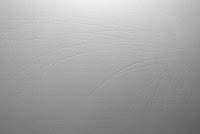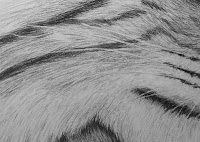 I've mentioned this "indent method" several times in past posts. Finally, here's a thorough explanation. The basic idea is to put a deep indent into the paper, so that when you draw over it with charcoal or graphite the indent leaves a white line. Any material that accidentally gets into the groove can be lifted out with a pointed kneaded eraser.
I've mentioned this "indent method" several times in past posts. Finally, here's a thorough explanation. The basic idea is to put a deep indent into the paper, so that when you draw over it with charcoal or graphite the indent leaves a white line. Any material that accidentally gets into the groove can be lifted out with a pointed kneaded eraser.You can use many tools to make the indent, so long as they don't leave a mark. Possible tools include a stylus, an empty pen or mechanical pencil, a toothpick, or a hard well-sharpened pencil over tracing paper. Test your tool on spare paper first to make sure it doesn't leave any mark.
 The fist image is of the bobcat's whiskers indented before any drawing was done. Since whiskers are important to leave very white, press very hard when indenting. You can get an idea of how hard by looking at the shadow on this photo. (Click the photo for a larger version.) I used a 2H graphite pencil over a piece of tracing paper. Now you can draw with a light touch right over the indents without getting pigment inside the groove. And after the fur was drawn in, I ran the kneaded eraser along the whiskers to pull out any charcoal that got inside. Then I traced along the lower edge with the 2B pencil to add a light shadow.
The fist image is of the bobcat's whiskers indented before any drawing was done. Since whiskers are important to leave very white, press very hard when indenting. You can get an idea of how hard by looking at the shadow on this photo. (Click the photo for a larger version.) I used a 2H graphite pencil over a piece of tracing paper. Now you can draw with a light touch right over the indents without getting pigment inside the groove. And after the fur was drawn in, I ran the kneaded eraser along the whiskers to pull out any charcoal that got inside. Then I traced along the lower edge with the 2B pencil to add a light shadow. In this last shot there are two things going on. First is the white whiskers above the eyes. I used the same method to indent as for the cheek whiskers, but instead of drawing over them, I dabbed the charcoal on with a chamois. This got a lot of charcoal in the grooves, but the kneaded eraser took care of that. The second point of this photo is the other application of the indent method - the small scale. I used an empty 0.3mm mechanical pencil to scratch fur in place. The length of the scratch is proportional to the length of the fur, and the depth is much more shallow than for the whiskers. Then I can draw over it just like the whiskers, but the white lines are smaller. Blending with a small stump puts a little charcoal into the grooves, but in this case it is desirable because I don't want pure white marks.
In this last shot there are two things going on. First is the white whiskers above the eyes. I used the same method to indent as for the cheek whiskers, but instead of drawing over them, I dabbed the charcoal on with a chamois. This got a lot of charcoal in the grooves, but the kneaded eraser took care of that. The second point of this photo is the other application of the indent method - the small scale. I used an empty 0.3mm mechanical pencil to scratch fur in place. The length of the scratch is proportional to the length of the fur, and the depth is much more shallow than for the whiskers. Then I can draw over it just like the whiskers, but the white lines are smaller. Blending with a small stump puts a little charcoal into the grooves, but in this case it is desirable because I don't want pure white marks.This technique will work in graphite as well as charcoal, and it is one way to make your fur drawings more realistic. Experiment with it to see what works for you.
2 comments:
Thanks for the tip. I had never thought of doing this and infact don't really do drawings so detailed and as a piece of art. But this sounds intriquing.
Thank you, Brenda. I like finding unusual methods for drawing.
Post a Comment